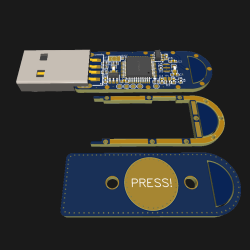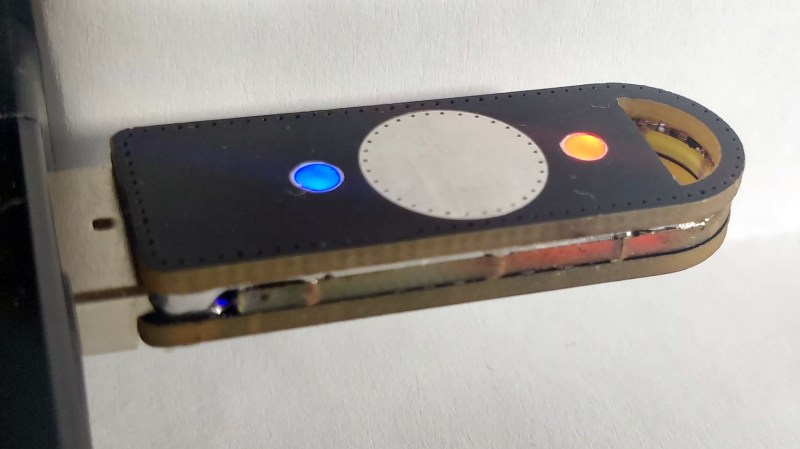[Samuel]’s first foray into making DIY hardware authentication tokens was a great success, but he soon realized that a device intended for everyday carry and use has a few different problems to solve, compared to a PCB that lives and works on a workbench. This led to TurtleAuth 2.1, redesigned for everyday use and lucky for us all, he goes into detail on all the challenges and solutions he faced.
 When we covered the original TurtleAuth DIY security token, everything worked fantastically. However, the PCB layout had a few issues that became apparent after a year or so of daily use. Rather than 3D print an enclosure and call it done, [Samuel] decided to try a different idea and craft an enclosure from the PCB layers themselves.
When we covered the original TurtleAuth DIY security token, everything worked fantastically. However, the PCB layout had a few issues that became apparent after a year or so of daily use. Rather than 3D print an enclosure and call it done, [Samuel] decided to try a different idea and craft an enclosure from the PCB layers themselves.
The three-layered PCB sandwich keeps components sealed away and protected, while also providing a nice big touch-sensitive pad on the top, flanked by status LEDs. Space was a real constraint, and required a PCB redesign as well as moving to 0402 sized components, but in the end he made it work. As for being able to see the LEDs while not having any component exposed? No problem there; [Samuel] simply filled in the holes over the status LEDs with some hot glue, creating a cheap, effective, and highly durable diffuser that also sealed away the internals.
Making enclosures from PCB material can really hit the spot, and there’s no need to re-invent the wheel when it comes to doing so. Our own [Voja Antonic] laid out everything one needs to know about how to build functional and beautiful enclosures in this way.















Nice build.
He should use it to add security traces into the pcb.
I have this temperature moderation mode where H2O leaks from my skin and evaporates, therefore anything inside an outer protective fabric envelope may be exposed to water vapor. Ergo everything that might be carried “on” me has to be hermetically sealed against vapor intrusion to survive.
Hmmm, I have a similar effect, but with an added quality that attacks most corrodable metals and some plastics. Afaik, my fingerprints are still on the Ku band radar in the shuttle @ Langley.
I’m slowly consuming this tungsten carbide ring my now wife gave me just before she became my wife.
Only things made of metal or polycarbonate seem to survive any amount of time around me.
I can’t seem to have anything on my wrist that isn’t good quality stainless steel or leather. Plastics seem to have about a month long armistice then get into a MAD mode where they both begin to decompose and irritate the hell out of my skin at the same time. The arms of spectacles seem to degrade pretty quickly too where they meet my temples, possibly accelerated by the many megawatts of brain power in close proximity, naturally ;-) but casualties there include titanium, carbon fibre, kevlar and most polycarbonates.
Does “durable” and “USB” really fit together in one sentence? I saw soo many users crying about dead USB ports already that I think they should be globally abolished and we should return to the robust DB9-like connectors again. USB only solves one problem: Being cheap.
USB A and B ports and cables are usually very durable, and USB C cables and ports are most definitely not that durable or cheap, and that is assuming you don’t get incompatible ones the first time…
The DB25 would work great for USB C just have to figure out how to make it reversible. Might as well use it for HDMI as well.
I carried several Yubikeys for 5-6 years, right next to my car and house keys on a key ring. Carried them in my pocket every day with absolutely no trouble. The things are close to indestructible.
I even got calls from a user who manged to mechanically kill the main-board of a desktop by mishandling an USB port. The USB plugs, memory sticks et al probably survive such in most cases, but the USB sockets often do not. I really have seen enough victims and I’m not a professional repairs shop, just a friendly neighbour who knows to code and to solder.
I’m sure you mean DE-9 …
Or a DB-5 for the best of the gadgets without the over complication. ;-)
I see so many devices about to become landfill because of USB (-C in particular) sockets. They are not bolted down to a PCB or attached to a front panel, they are surface mounted soldered to inadequate areas of thin PCB copper. In use a plug is repeatedly shoved in and out that is on the end of a cable that is tugged in all directions.
Of course the manufacturer doesn’t mind because the user will go out and buy another device. In fact I suspect many users don’t mind too much either because it gives them an excuse to go shopping and buy the latest and greatest.
USB-C socket with PTH mechanical pin for paste in pads or wave soldering are available (vertical, right angle, flush and event flag type) and are close to indestructible.
Also SMD version with right angle nuts insert for front panel bolting, used for watertight application with a gasket.
Beside the cost (will come down eventually) , USB type C is very good.
nice but…. how check what I signed?